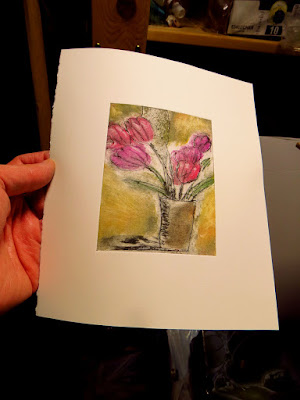Progress has been happening with a series of miniature intaglio prints that began a few years ago when I decided to use up a few pieces of scrap polymer plates being stored in a small box in the studio. They are based on a common theme of birds found here in the region of Ontario where I reside.
The plan was to create art on a small scale and transfer the work to a plate. The plate would be inked and printed onto rag paper using an etching press.
 |
scale of work compared to a $2 Canadian coin which is
slightly larger than a $0.25 cent coin).
Print size is 1.25 x 1.75 inches (3 x 4.5 cm) |
My very first study from one of those small plates was of a chickadee at a feeder. The square plate size measured 1 inch (2.5 cm).
chickadee 2015
Translating hand-drawn artwork onto a plate
I took a sketch made on paper and made a high resolution scan of it.
Using a photoshop program the contrast was adjusted in the scanned image. I also adjusted the tone and lightened the image that was being viewed on screen by 20%.This was printed using grayscale setting with black ink only option from a HP inkjet printer. It was printed onto an inkjet transparency.
I placed the transparency tightly against a thin metal plate that had a thin coat of light-sensitive polymer fused onto it's surface. I clamped the transparency to sandwich it between a small cut piece of tempered clear glass and a wood backing board that had a thin piece of bubble wrap taped along the edges. Using four inexpensive plastic shop clamps (these resemble large close pins) I clamp in on the glass and board from the corners about .5 inches (13 mm). You need to have the artwork pressed flush against the plate but clearly visible for ultra-violet light to create a chemical reaction in the polymer.
The art work and plate received a timed 3 minutes of exposure to a UV light source (a small box chamber I had constructed several years back). It had four banks of 18 inch(.5 metre) long black lights mounted to the underside the box inside). Black light emits ultra-violet spectrum light. If there are clear sunny skies you can also expose the plate outdoors.
Plates post-exposure are developed using warm tap water and gentle scrubbing using an old toothbrush. I blot the wet plate after the image appears etched into the polymer surface. The plate is then exposed once again to UV light for ten minutes to harden the polymer to create a permanent set.
I wipe oil based (non-toxic) etching ink into the plate surface. The ink by wiping into shallow pitted surface areas that will reproduce the image from its surface when very intense pressure is applied from a press roller passed over the plate surface.
Hand colouring images
Since it would be very difficult to wipe various colours of etching inks into lines in very small plates I paint colour into the image using brush and watercolour pigment. Each print varies slightly and is unique unto itself in application of the colouring.
Bird Series - Intaglio based miniature prints
After printing a small edition of the chickadee I made a decision to expand on the miniature plate intaglio process and develop this into a series.
Downy was the next original image that began as artwork on a positive and was once again translated to polymer plate.
Downy 2017
This was followed a few months later with the study of a blue jay.
Bluejay 2017
Drypoint plate intaglio
Beginning 2018 with renewed creative energy I have continued the series by adding another two added to the collection (see photos below). To date there are now a total of five prints in the series. I am still in the process of applying hand colouring to the new works (printed in editions of 15).
This time I used drypoint as the medium. Each originates from a drawing scratched into the surface of a clear hard acrylic plate with an etching needle. I can put my sketch underneath and use it as a guide to scratch in the image.
The plates then have etching ink wiped into the surface marks. Damp paper is set over top of the plate (set on a movable bed) and by turning the gear handles manually they are passed under a stainless steel roller. The extreme meeting of the paper and plate surface literally drives the paper fiber into the recessed inked lines to transfer the image (in reverse) onto the paper.
Colour is introduced after the print has dried once again through diluted watercolour pigment applied with brush.
nuthatch 2018
Whiskey Jack 2018
The plan is to continue adding new studies to the series. In the meantime I will be making these available through both local venue and an online handmade retail site (Etsy).










.jpg)



















































